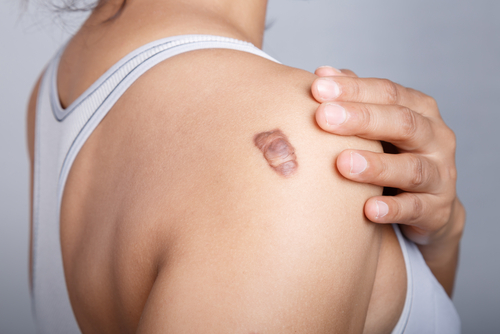Keloids are a type of raised scar that emerges on the skin after an injury has healed; they can grow to be considerably larger than the damage that caused the scar to appear in the first place.
A keloid can occur as a result of anything that causes a scar, such as being burnt, injured, or having severe acne; keloids can also form as a result of a body piercing, tattoo, or surgery. This sort of scarring can occur three months or more after a patient’s skin has been injured, and some will continue to expand for years.
What causes Keloid Scars?
When people’s skin is damaged, their cells attempt to repair it by producing a scar. Some people’s scar tissue continues to develop even after the wound has healed. A keloid, or raised area on the skin, is formed by the extra scar tissue.
A number of skin traumas can result in keloid development. Here are a few examples:
- Cuts
- Wounds
- Surgical scarring
- Severe acne
- Insect bites
- Chicken pox
- Tattoos
- Injections
- Piercings
Some people are more prone to developing keloid scars than others. Your patient is more likely to develop a keloid if they have any of the following conditions:
- If they are black, Latino, or Asian,
- Under thirty years old
- Expecting a child
- If they are in the middle of puberty
- If they or their family has a history of keloids
Symptoms and indicators of keloid scars
Keloids have the following characteristics:
- Slowly emerge and expand. A keloid’s first indications might occur anywhere from three months to a year. After then, it takes weeks or months to grow. They can develop very slowly for years at a time.
- Begin with a raised pink, red, or purple scar. A keloid is often a raised scar with a flat surface. The colour begins to deepen with time. It is often darker than the person’s skin tone, with the perimeter being darker than the centre.
- Feel different in comparison to the rest of the skin. The texture of certain keloids is mushy and doughy. Others have a rough, rubbery texture.
- It is possible that individuals will have pain, itching, or discomfort. As keloids expand, they can become itchy, unpleasant, or painful to touch. These symptoms normally go away once the keloid stops developing.
Keloids can show up anywhere on the body. The most usually affected regions are the neck, shoulders, chest, back, and ears. They can range in size from one inch to 12 inches or more.
How are keloid scars treated?
The purpose of therapy is to flatten, soften, or reduce the keloid. Keloids are notoriously tough to get rid of. They could recur after therapy. Many physicians will combine therapies to achieve the greatest results. Some of the therapies are as follows:
- Corticosteroid injections – The medication in these shots helps to reduce scarring.
- PRP – Scar treatment with PRP injections lessens or removes scars by stimulating connective tissue and epidermal cells called fibroblasts and keratinocytes. When these skin-related cells multiply in number, new collagen is created. RegenLab’s RegenKit ACR is a popular product utilized by many practitioners and clinics.
- Cryotherapy – A method that can be used to reduce the size and hardness of a keloid. It works well on keloids that are small.
- Covering the scar with silicone sheets or gel – This may help the keloid flatten.
- Laser therapy – A sort of treatment that can help with keloid flattening. It’s also possible that the colour will fade.
Surgical removal – The keloid is surgically removed. The majority of keloids will return after this therapy.
PRP Supplier
If you’re looking for the best PRP kits for your clinic, please get in touch. We are a UK PRP supplier to a range of medical clinics.

